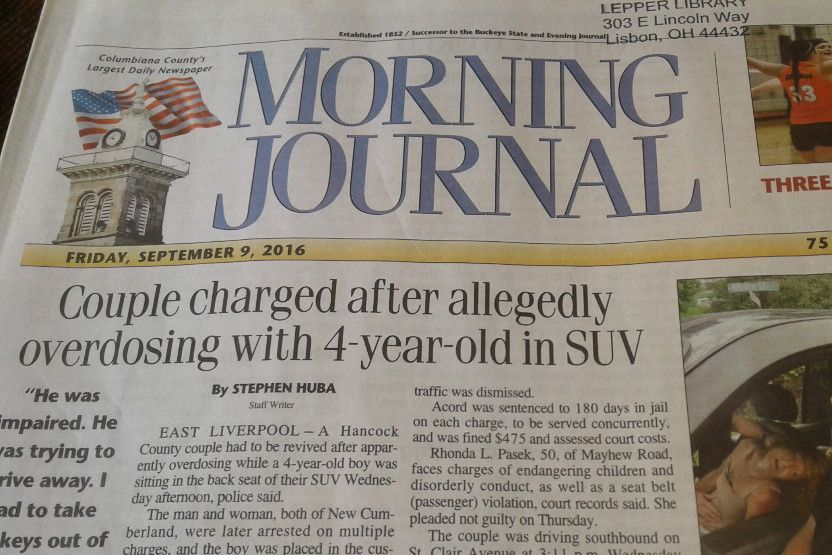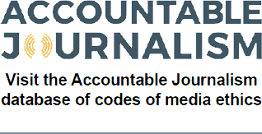How the Rush to Publish Traps a Newspaper and Trashes Standards
Tom Law
The United States news media are famously jealous of their freedom and journalistic rights. In many ways, over the years they have shown how self-regulation can work, even in troubled times. But an incident in Ohio last week illustrated just how fragile attachment to ethics and standards can be when there is a rush to publish.
Two photos taken by the Ohio Police Department, were posted on Facebook, and reprinted by Ogden Newspapers in Columbiana County, showing two unresponsive adults in a vehicle, with a four-year-old boy in the backseat. The adults, the boy’s grandmother and her friend, had overdosed on heroin and the emergency services were yet to arrive. The face of the child, who is the only person alert in the picture, is clearly visible.

Photo of the Morning Journal front page on 9 September 2016 with an unedited photo of a four-year-old boy with his grandmother and her friend having passed out in the front seat. We have cropped the image to avoid showing his face.
After the photos were posted on the East Liverpool Police Department’s Facebook page they were quickly picked up by local news outlets including the Morning Journal which printed one of the photos on the front page on 9 September, with the boy’s face clearly shown.
“We are well aware that some may be offended by these images and for that we are truly sorry, but it is time that the non-drug-using public sees what we are now dealing with on a daily basis,” the police wrote in comments accompanying the photos.
The Facebook post added: “The poison known as heroin has taken a strong grip on many communities, not just ours – the difference is we are willing to fight this problem until it’s gone, and if that means we offend a few people along the way we are prepared to deal with that.”
Some comments under the photo were approving, while others, including one reader of the Morning Journal, contacted the EJN to express their concern that both the police department and local press had released the identity of a vulnerable child. The boy has since been taken into care and, according to The Independent, is on his way to a new home.
When the story was picked up by national and international news outlets, picture editors decided to blur the child’s face. Following criticism, Ogden Newspapers published two stories defending the release of the image quoting the East Liverpool Police Chief and City Manager and a professor of criminal justice from Pittsburgh.

Neither article was balanced with the opinions of health or child development professionals. With the US having no functioning press councils it is often unclear where complaints by readers can be made unless the newspaper group has its own ombudsman.
The debate over press regulation in the US is a long and complicated one, as outlined by Bill Orme’s article for the EJN on the subject published last year, which questioned the case for American exceptionalism when it comes to regulating the press.
As with all editorial decisions, there are rarely any absolutes.

Five-year-old Omran Daqneesh in an ambulance after an alleged airstrike hit a house in Aleppo on August 17, 2016. ALEPPO MEDIA CENTER:@AleppoAMC
August’s powerful photograph and short video of five-year-old Omran Daqneesh sitting in an ambulance in the aftermath of an airstrike in Aleppo was published widely without editors choosing to obscure his identity.
But unlike the police in Ohio, responsible news editors would have consulted their editorial codes before deciding how to use the photo.
Ironically, considering the recent fiasco of Facebook’s short-lived censorship of arguably the most famous image of the Vietnam war, the sharing of an image of a boy who was fully clothed has had far more potential to do harm than the republication of Phan Thị Kim Phúc’s nine-year-old self fleeing naked from a Napalm attack in 1972.
As the EJN argued earlier this week, it is precisely because making these ethical judgements is such a fine balancing act that trained editors, who are accountable to their readers through self-regulatory systems, are far more likely to make the right call. Incidents such as this strengthen the argument that social media platforms and organisations that use them, including police departments, should make public their editorial guidelines and ensure that the public have adequate mechanisms to have complaints responded to.

To aid this process the EJN has worked with the Reynolds Journalism Institute at the Missouri School of Journalism to curate a database of ethics codes and press councils from around the world. This resource can be used any publisher or regulatory body to act as a reference as they develop their own standards and guidelines.
Main photo: A version of the Ohio Police facebook photo, published by The Independent, with the child’s face redacted.